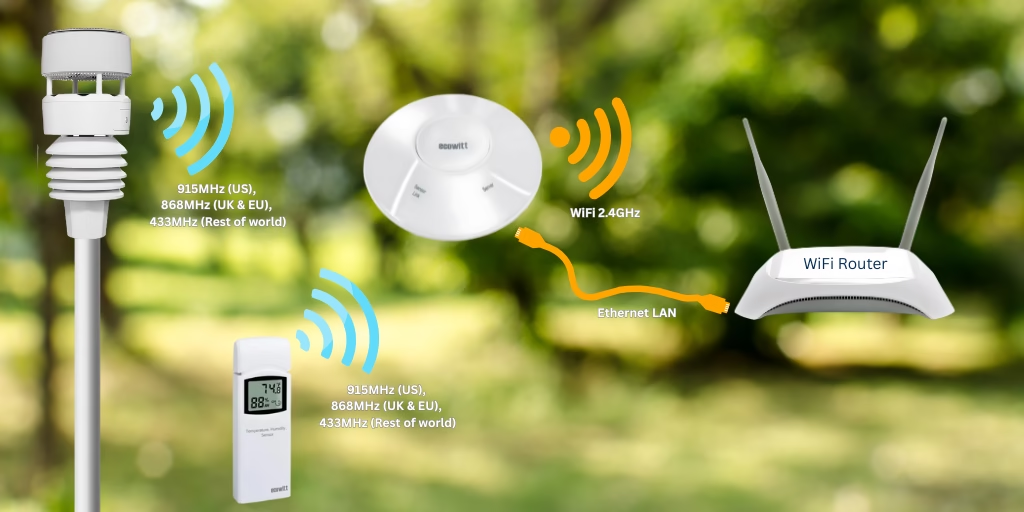Ecowitt Wireless Connectivity Information
Ecowitt offers a flexible system of wireless environmental sensors that connect to a central gateway. Understanding how these devices communicate, the range, frequencies used, and how internet access fits into the setup is useful to know when installing an Ecowitt system.
Sensors Connect to a Gateway
Ecowitt sensors like rain gauges, temperature probes, soil moisture sensors, air quality monitors and full weather stations don’t connect directly to Wi-Fi. Instead, they transmit data wirelessly to a gateway or display console. Common gateway options are:
- GW1100, GW2000, & GW3000: Compact USB-style gateways with no display.
- HP2551C or HP3501: Full-colour display consoles that act as both display and data hub.
These gateways are the bridge between your Ecowitt sensors and the internet or your local network.
How Devices Connect
Sensors communicate with the gateway using low-frequency RF signals, not Wi-Fi or Bluetooth, Zigbee or other wireless protocols often used in smart home systems. Instead the Ecowitt wireless method allows for low power usage and long-range communication, which is ideal for outdoor environments.
When powered on, most Ecowitt gateways will automatically detect and pair with compatible sensors within range. Some setups allow you to manually assign sensor IDs if you’re using multiple of the same sensor type. Please note, gateways and display consoles have a maximum number of devices that can connect, see the Ecowitt compatibility table for more details.
Wireless Frequencies Used – 433 MHz, 868 MHz, 915 MHz
Ecowitt devices use different frequencies depending on the region, due to national radio regulations:
- 433 MHz: Used in Australia, parts of Asia, and some other international regions.
- 868 MHz: Used in most of Europe and the UK
- 915 MHz: Used in the United States, Canada, and Mexico.
When buying Ecowitt products, make sure the frequency matches your country’s standard. Devices and gateways must use the same frequency to work together, they are not cross-compatible.
Wireless Range
In open conditions, Ecowitt’s RF signal can reach up to 100 metres (about 328 feet) from sensor to gateway. In real-world use, the range will be affected by:
- Thick walls, trees, or other obstacles
- Interference from nearby electronics
- Gateway placement (central placement is best for multi-sensor setups)
For larger properties, consider the line-of-sight and avoid installing sensors too far from the gateway or in signal blocked locations.
Is an Internet Connection Required for Ecowitt
Ecowitt Sensors do not require internet to communicate with the gateway. You can collect and view data locally without an internet connection.
However, if you want to:
- View data remotely (via app or web)
- Send data to Ecowitt.net or third-party weather services (e.g. Weather Underground, WeatherCloud)
- Receive firmware updates
then an internet connection is required.
How the Gateway Connects to the Internet
Gateways connect to your home or office internet using either:
- Wi-Fi: Used by gateways and display consoles.
- Wired Ethernet (network cable): Available on some models like the GW2000, which has an Ethernet port for direct connection to a router or switch.
You’ll use the Ecowitt mobile app or web interface to set up your Wi-Fi details during initial configuration.
Summary
- Sensors connect wirelessly to a gateway using low-frequency RF (433, 868, or 915 MHz).
- Gateways connect to the internet via Wi-Fi or Ethernet.
- Devices range is up to 100 metres, depending on conditions.
- Internet is optional for local use but required for cloud access, remote viewing, and firmware updates.
- Frequency compatibility matters: choose the correct version for your region 868MHz (US), 915 MHz (UK \ EU) and 433MHz (rest of world).
Ecowitt’s modular setup makes it a great choice for outdoor environments, gardens, farms, smart homes and weather enthusiasts. With the right setup, you can monitor local conditions reliably, online or offline.





